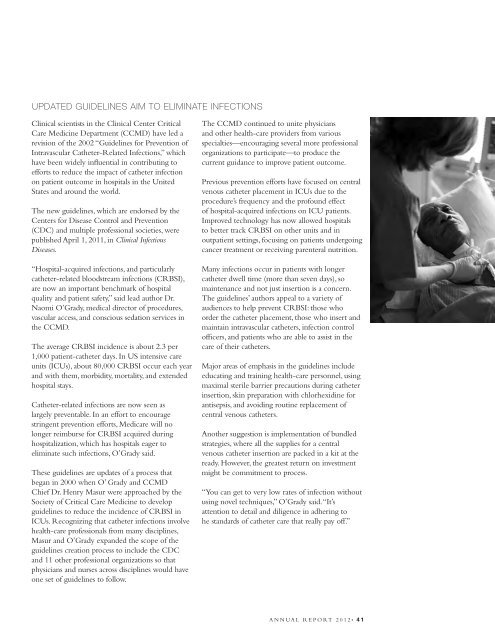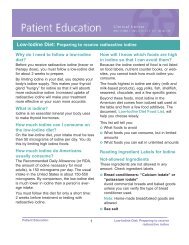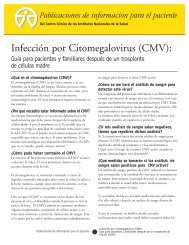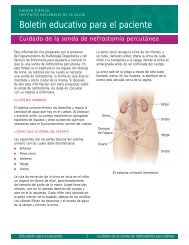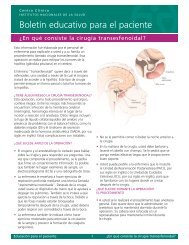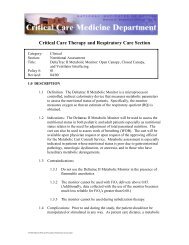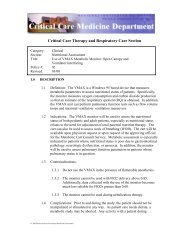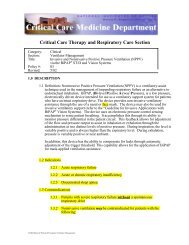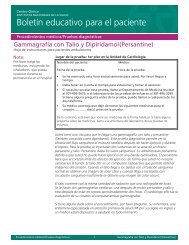NIH Clinical Center Profile 2012 - Search - National Institutes of Health
NIH Clinical Center Profile 2012 - Search - National Institutes of Health
NIH Clinical Center Profile 2012 - Search - National Institutes of Health
You also want an ePaper? Increase the reach of your titles
YUMPU automatically turns print PDFs into web optimized ePapers that Google loves.
UPDATED GUIDELINES AIM TO ELIMINATE INFECTIONS<br />
<strong>Clinical</strong> scientists in the <strong>Clinical</strong> <strong>Center</strong> Critical<br />
Care Medicine Department (CCMD) have led a<br />
revision <strong>of</strong> the 2002 “Guidelines for Prevention <strong>of</strong><br />
Intravascular Catheter-Related Infections,” which<br />
have been widely influential in contributing to<br />
efforts to reduce the impact <strong>of</strong> catheter infection<br />
on patient outcome in hospitals in the United<br />
States and around the world.<br />
The new guidelines, which are endorsed by the<br />
<strong>Center</strong>s for Disease Control and Prevention<br />
(CDC) and multiple pr<strong>of</strong>essional societies, were<br />
published April 1, 2011, in <strong>Clinical</strong> Infectious<br />
Diseases.<br />
“Hospital-acquired infections, and particularly<br />
catheter-related bloodstream infections (CRBSI),<br />
are now an important benchmark <strong>of</strong> hospital<br />
quality and patient safety,” said lead author Dr.<br />
Naomi O’Grady, medical director <strong>of</strong> procedures,<br />
vascular access, and conscious sedation services in<br />
the CCMD.<br />
The average CRBSI incidence is about 2.3 per<br />
1,000 patient-catheter days. In US intensive care<br />
units (ICUs), about 80,000 CRBSI occur each year<br />
and with them, morbidity, mortality, and extended<br />
hospital stays.<br />
Catheter-related infections are now seen as<br />
largely preventable. In an effort to encourage<br />
stringent prevention efforts, Medicare will no<br />
longer reimburse for CRBSI acquired during<br />
hospitalization, which has hospitals eager to<br />
eliminate such infections, O’Grady said.<br />
These guidelines are updates <strong>of</strong> a process that<br />
began in 2000 when O’ Grady and CCMD<br />
Chief Dr. Henry Masur were approached by the<br />
Society <strong>of</strong> Critical Care Medicine to develop<br />
guidelines to reduce the incidence <strong>of</strong> CRBSI in<br />
ICUs. Recognizing that catheter infections involve<br />
health-care pr<strong>of</strong>essionals from many disciplines,<br />
Masur and O’Grady expanded the scope <strong>of</strong> the<br />
guidelines creation process to include the CDC<br />
and 11 other pr<strong>of</strong>essional organizations so that<br />
physicians and nurses across disciplines would have<br />
one set <strong>of</strong> guidelines to follow.<br />
The CCMD continued to unite physicians<br />
and other health-care providers from various<br />
specialties—encouraging several more pr<strong>of</strong>essional<br />
organizations to participate—to produce the<br />
current guidance to improve patient outcome.<br />
Previous prevention efforts have focused on central<br />
venous catheter placement in ICUs due to the<br />
procedure’s frequency and the pr<strong>of</strong>ound effect<br />
<strong>of</strong> hospital-acquired infections on ICU patients.<br />
Improved technology has now allowed hospitals<br />
to better track CRBSI on other units and in<br />
outpatient settings, focusing on patients undergoing<br />
cancer treatment or receiving parenteral nutrition.<br />
Many infections occur in patients with longer<br />
catheter dwell time (more than seven days), so<br />
maintenance and not just insertion is a concern.<br />
The guidelines’ authors appeal to a variety <strong>of</strong><br />
audiences to help prevent CRBSI: those who<br />
order the catheter placement, those who insert and<br />
maintain intravascular catheters, infection control<br />
<strong>of</strong>ficers, and patients who are able to assist in the<br />
care <strong>of</strong> their catheters.<br />
Major areas <strong>of</strong> emphasis in the guidelines include<br />
educating and training health-care personnel, using<br />
maximal sterile barrier precautions during catheter<br />
insertion, skin preparation with chlorhexidine for<br />
antisepsis, and avoiding routine replacement <strong>of</strong><br />
central venous catheters.<br />
Another suggestion is implementation <strong>of</strong> bundled<br />
strategies, where all the supplies for a central<br />
venous catheter insertion are packed in a kit at the<br />
ready. However, the greatest return on investment<br />
might be commitment to process.<br />
“You can get to very low rates <strong>of</strong> infection without<br />
using novel techniques,” O’Grady said. “It’s<br />
attention to detail and diligence in adhering to<br />
he standards <strong>of</strong> catheter care that really pay <strong>of</strong>f.”<br />
A N N U A L R E P O RT 2 0 1 2 • 4 1


